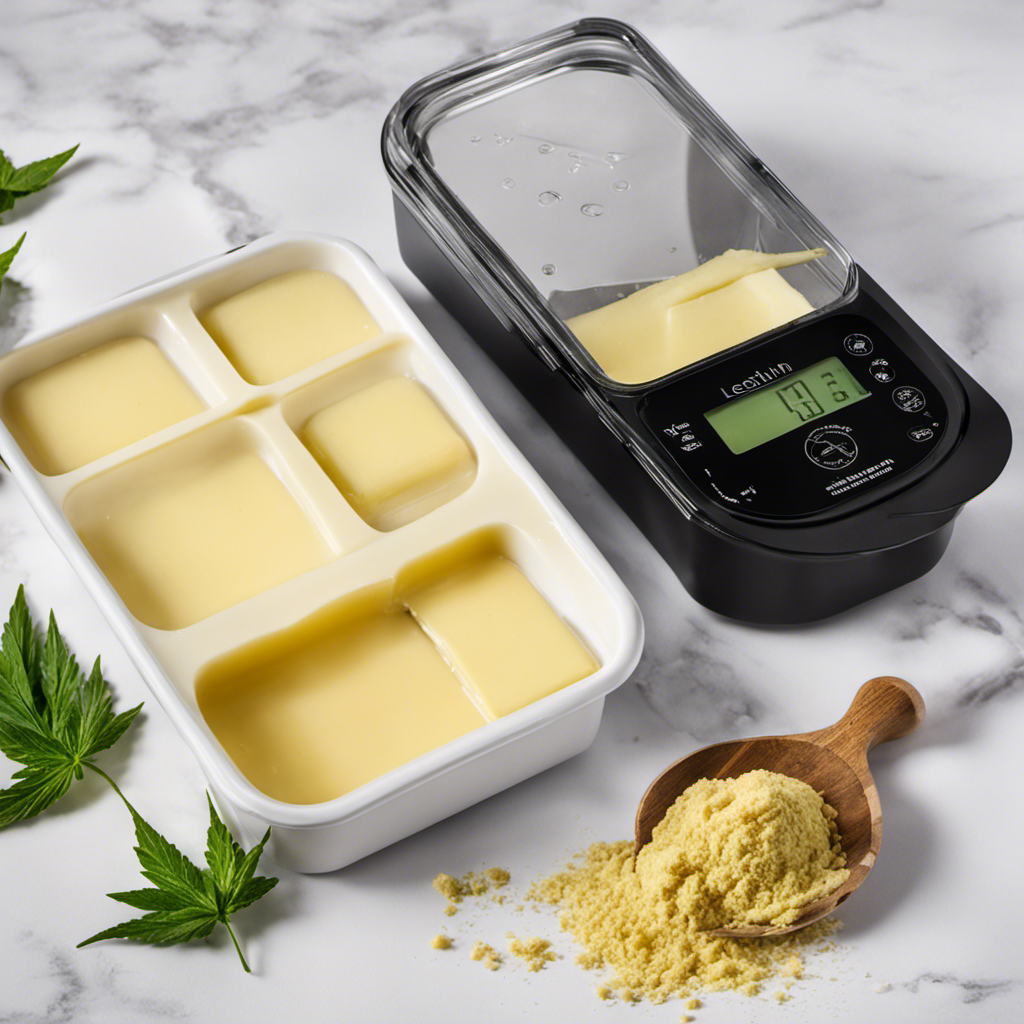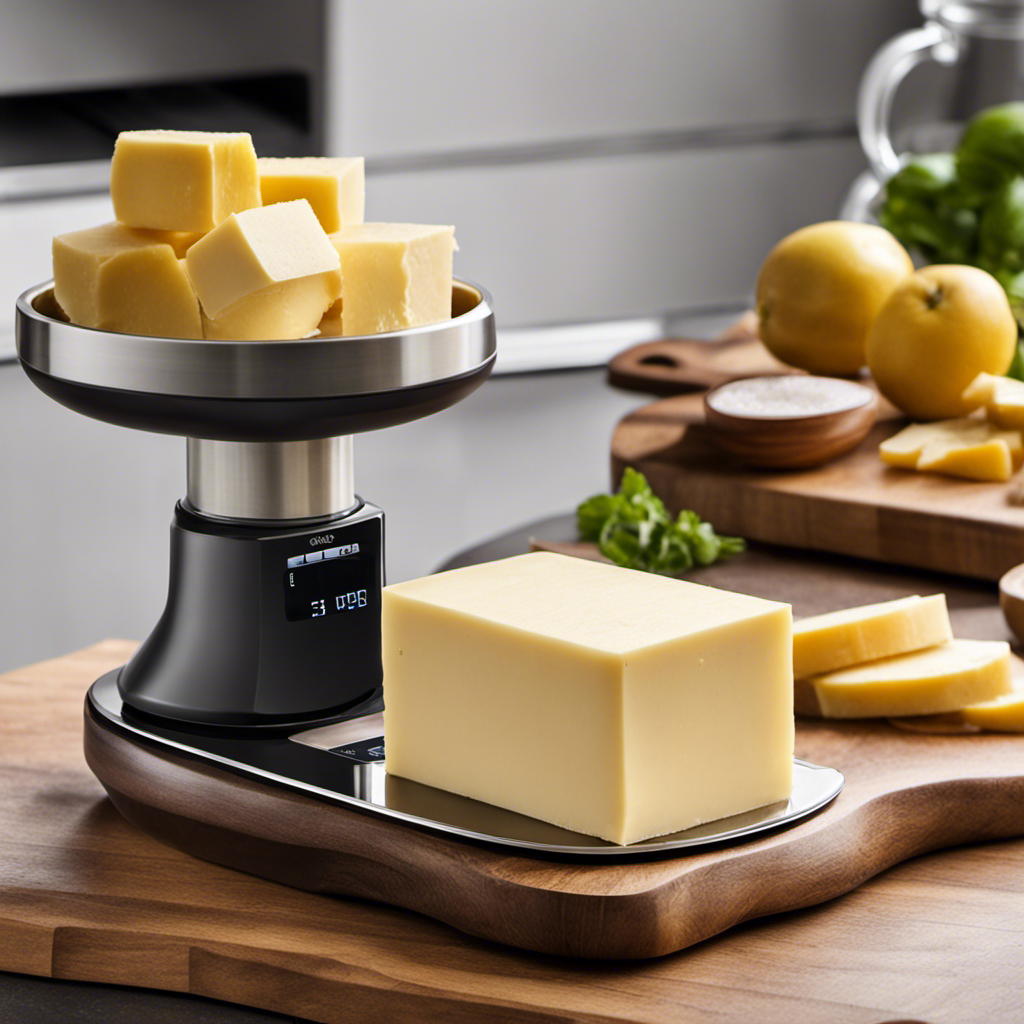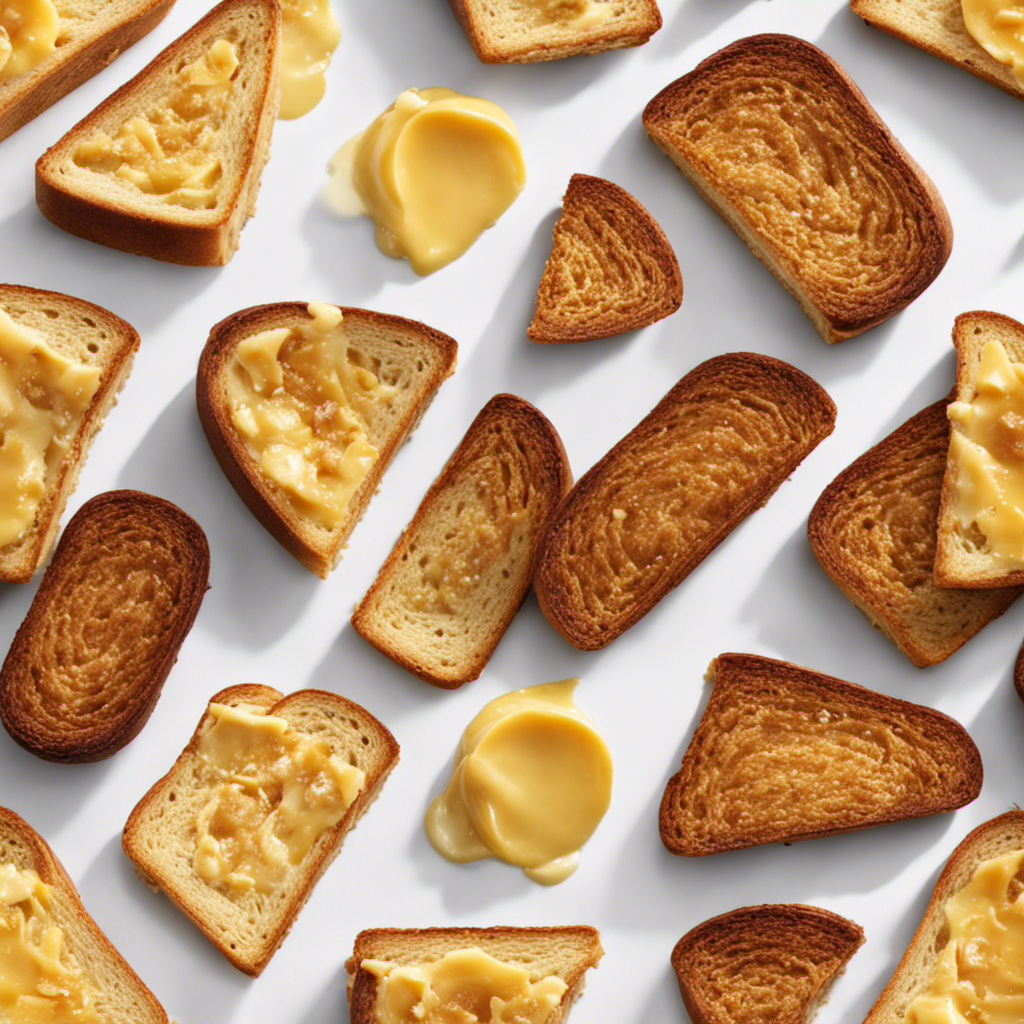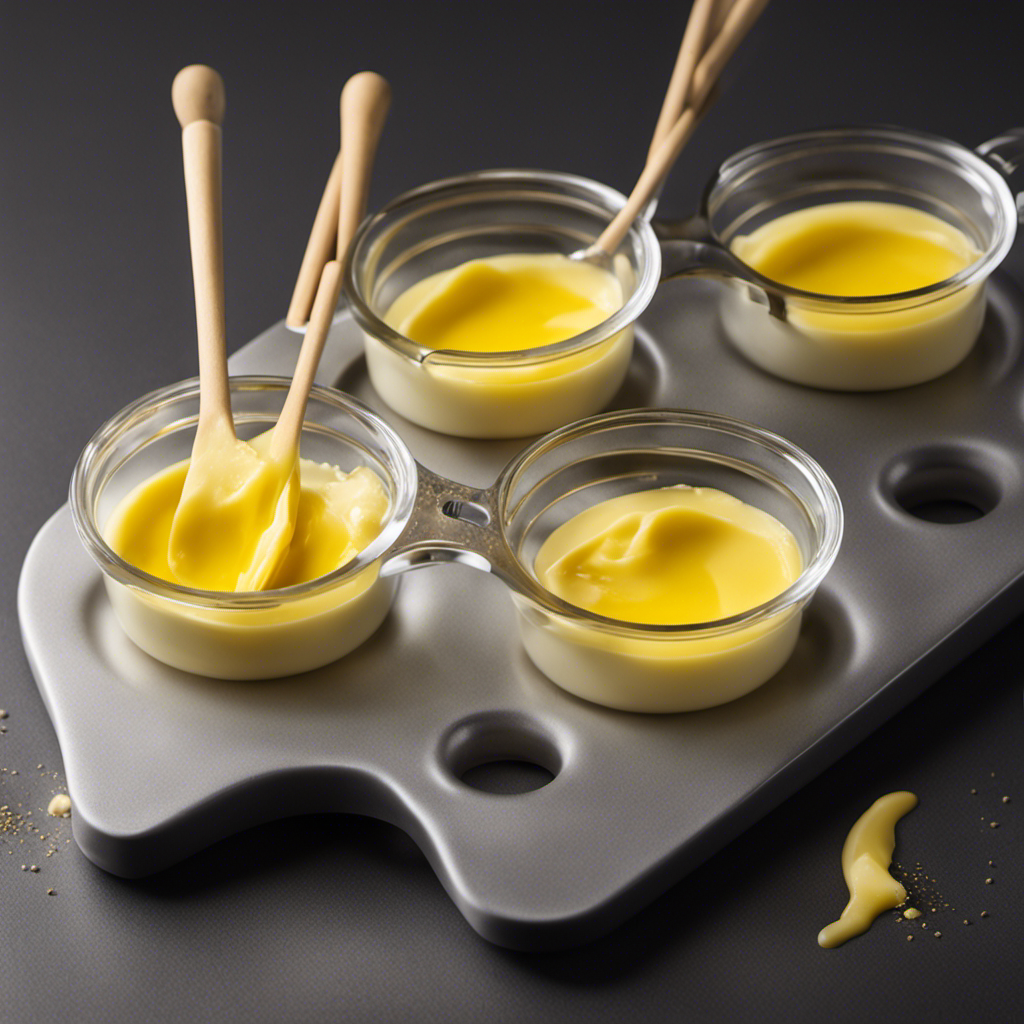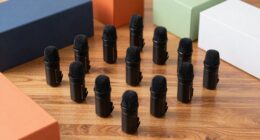I’ve found out that incorporating lecithin into my cannabutter, which I produce using the Easy Butter Maker, has greatly improved both the quality and strength of my edibles. Indeed, research indicates that the addition of lecithin can boost the bioavailability of cannabinoids by as much as 40%.
It’s an essential ingredient that enhances the texture and consistency of the final product. But how much lecithin should I use? In this article, I’ll provide you with all the information you need to determine the ideal lecithin dosage for your cannabutter.
Key Takeaways
- Lecithin enhances the absorption of cannabinoids in the body.
- Adding lecithin increases the bioavailability of cannabinoids by up to 40%.
- Lecithin acts as an emulsifier, binding cannabinoids with fats effectively.
- Calculating the ideal lecithin dosage is crucial for achieving desired potency and consistency.
The Importance of Lecithin in Cannabutter Making
Lecithin is essential in cannabutter making because it helps to enhance the absorption of cannabinoids in the body. Understanding lecithin’s role in improving the cannabis infusion process is crucial for achieving a more potent and effective end product.
Lecithin is a natural emulsifier that can be derived from sources such as soybeans or sunflower seeds. When added to the cannabutter mixture, it acts as a binding agent, allowing the cannabinoids to be more easily absorbed by the body.
The impact of lecithin on the bioavailability of cannabinoids is significant. Bioavailability refers to the degree and rate at which a substance is absorbed into the bloodstream. By incorporating lecithin into the cannabutter, the bioavailability of the cannabinoids is increased, leading to a more efficient uptake and utilization by the body.
In addition to improving absorption, lecithin also aids in the overall infusion process. It helps to evenly distribute the cannabinoids throughout the butter, ensuring that each serving contains a consistent potency. This is especially important when making edibles, as it allows for a more predictable and enjoyable experience.
Understanding the role of lecithin in the easy butter maker is essential for achieving optimal results. With the knowledge of how lecithin enhances absorption and improves the infusion process, you can confidently use the easy butter maker to create potent and delicious cannabutter.
Understanding the Role of Lecithin in Easy Butter Maker
To fully comprehend the significance of its role in the Easy Butter Maker, you should understand how lecithin impacts the infusion process. Lecithin is a vital ingredient when it comes to making cannabutter using the Easy Butter Maker. Here are a few key points to consider about lecithin dosage effectiveness and its relationship with infusion techniques:
-
Lecithin dosage effectiveness: The amount of lecithin used can greatly affect the potency and consistency of your infused butter. It is important to find the right balance to achieve the desired results.
-
Improved infusion: Lecithin acts as an emulsifier, allowing the cannabinoids in your cannabis to bind more effectively with the fats in the butter. This leads to a more efficient infusion process and a stronger end product.
-
Enhanced bioavailability: Lecithin helps improve the bioavailability of the cannabinoids, making them more easily absorbed by the body. This can result in a faster onset of effects and a more potent experience.
-
Homogenous mixture: Lecithin helps create a homogenous mixture by preventing the separation of the cannabinoids and fats. This ensures that each batch of cannabutter is consistent in potency throughout.
Understanding the role of lecithin in the Easy Butter Maker is crucial for achieving the best results. Now, let’s delve into the factors to consider when determining the quantity of lecithin to use in your cannabutter.
Factors to Consider When Determining Lecithin Quantity
When it comes to making cannabutter, there are several key factors to consider in order to achieve the desired potency and consistency.
One of these factors is the cooking temperature, which has a significant impact on the final product. By understanding how different temperatures affect the infusion process, it becomes easier to control the potency of the cannabutter.
Additionally, maintaining a consistent temperature throughout the cooking process is crucial in ensuring that the cannabinoids are properly activated and evenly distributed in the butter.
Cooking Temperature’s Impact
You’ll want to keep in mind that cooking temperature plays a significant role in the final outcome of your cannabutter. The temperature you choose will affect both the cooking time and the infusion process, so it’s important to get it right.
Here are a few things to consider when it comes to cooking temperature:
-
Low and slow: Cooking your cannabutter at a low temperature for a longer period of time can help to preserve the potency of the cannabinoids and ensure a smooth infusion process.
-
Avoid high heat: Cooking at high temperatures can cause the cannabinoids to degrade, resulting in a less potent end product.
-
Maintain consistency: Keeping the temperature steady throughout the cooking process will help to ensure that your cannabutter has a consistent potency and flavor.
-
Use a thermometer: Investing in a good quality thermometer can help you accurately monitor and control the cooking temperature, resulting in a better final product.
By paying attention to the cooking temperature, you can achieve the desired potency and consistency in your cannabutter.
Now let’s move on to the next section to explore more factors that can affect the outcome.
Desired Potency and Consistency
Maintaining a consistent cooking temperature is crucial for achieving the desired potency and consistency in my cannabutter. The ideal dosage of lecithin is an important factor to consider in this process. Lecithin acts as an emulsifier, helping to bind the cannabinoids and fats together, resulting in a more potent and evenly distributed product.
While lecithin is commonly used, there are also substitutes available such as sunflower lecithin or soy lecithin. These alternatives can be used in the same way as traditional lecithin, providing similar benefits.
Calculating the ideal lecithin dosage for cannabutter requires considering factors such as the desired potency, the amount of butter used, and personal preferences. By understanding the importance of lecithin and its substitutes, I can ensure that my cannabutter turns out just the way I want it.
Now, let’s delve into calculating the ideal lecithin dosage for cannabutter.
Calculating the Ideal Lecithin Dosage for Cannabutter
When it comes to using lecithin in recipes, there are several dosage considerations to keep in mind. The ideal dosage can vary depending on factors such as the potency of the cannabis and the desired effects.
To maximize the potency of your cannabutter, it is important to understand the role of lecithin and how to use it effectively.
Lecithin Dosage Considerations
To achieve optimal results, it’s important to consider the dosage of lecithin when making cannabutter using the Easy Butter Maker. Lecithin acts as an emulsifier, helping to bind the cannabinoids and terpenes in the cannabis to the fats in the butter.
Here are some key considerations for lecithin dosage:
-
Start with a low dosage: It’s best to start with a small amount of lecithin, such as 1 teaspoon per cup of butter, and gradually increase if needed.
-
Different recipes may require different dosages: The amount of lecithin needed can vary depending on the specific cannabis-infused recipe you’re making. Experimentation is key.
-
Potential side effects of excessive lecithin consumption: Consuming excessive amounts of lecithin can lead to digestive issues such as diarrhea and nausea. It’s important to find the right balance.
Maximizing Potency With Lecithin
One way to maximize potency in your cannabis-infused treats is by experimenting with different dosages of lecithin. Lecithin is a natural emulsifier that can enhance the absorption and bioavailability of cannabinoids in your edibles. Adding lecithin to your cannabis recipes can help increase the potency of the final product, making it more effective and efficient.
Here is a table showing different dosages of lecithin and their benefits in cannabis recipes:
| Lecithin Dosage | Benefits |
|---|---|
| 1 teaspoon | Improved texture and consistency |
| 1 tablespoon | Enhanced potency and bioavailability |
| 2 tablespoons | Increased absorption of cannabinoids |
Recommended Lecithin Ratios for Different Cannabutter Recipes
Using lecithin in different cannabutter recipes can enhance the potency and texture of the final product. It’s important to adjust the lecithin ratios based on the recipe you’re using to achieve the desired effects.
Here are some lecithin dosage guidelines to consider:
-
Start with a small amount: When incorporating lecithin into your cannabutter recipe, start with a small amount and gradually increase the dosage to find the right balance. This will help you avoid overpowering the flavor and potency of the butter.
-
Consider the potency of your cannabis: The amount of lecithin needed may vary depending on the potency of your cannabis. If you’re using a highly potent strain, you might need less lecithin to achieve the desired effects.
-
Experiment with different ratios: It’s recommended to start with a 1:1 ratio of lecithin to cannabis, but you can experiment with different ratios to find what works best for you. Some people prefer a higher ratio of lecithin for increased potency, while others prefer a lower ratio for a milder experience.
-
Observe the effects: Pay attention to how your body reacts to the cannabutter with different lecithin ratios. Adjust the amounts accordingly to achieve the desired effects.
Adjusting Lecithin Amounts Based on Desired Potency
When it comes to using lecithin in my cannabis-infused recipes, I always strive to find the optimal dosage. This is crucial in achieving the desired potency of my edibles while also considering the impact on taste.
Balancing both factors is essential to create a product that not only delivers the desired effects but also pleases the palate.
Optimal Lecithin Dosage
To achieve the optimal lecithin dosage in your cannabutter made with the Easy Butter Maker, you should start with a small amount and gradually increase it until you find the perfect balance. Lecithin dosage can vary depending on the cooking method you choose.
Here are some important points to consider:
- For baking: Use 1 teaspoon of lecithin per cup of butter.
- For stovetop cooking: Start with ½ teaspoon of lecithin per cup of butter and adjust as needed.
- For slow cooking methods: Increase the lecithin dosage to 2 teaspoons per cup of butter.
Excessive use of lecithin can have potential side effects, such as gastrointestinal discomfort or allergic reactions. It is important to use it in moderation and listen to your body’s response.
Finding the right lecithin dosage is crucial for achieving the desired effects in your cannabutter. Now let’s explore how to balance potency and taste to create the perfect infusion.
Balancing Potency and Taste
Finding the right balance between potency and taste is essential for creating the perfect infusion. When it comes to making cannabutter, using lecithin can have a significant impact on both flavor and effectiveness.
Lecithin is a natural emulsifier that helps bind fats and water, resulting in a smoother and more homogenous mixture. This not only improves the texture of your cannabutter but also enhances its flavor by evenly distributing the cannabinoids throughout the infusion.
However, it’s crucial to find the right dosage of lecithin to avoid overpowering the taste of your final product. Too much lecithin can give your cannabutter a strong, bitter taste, while too little may not provide the desired effects on flavor.
To achieve the perfect balance, it’s important to experiment and find the ideal amount of lecithin that suits your taste preferences. Understanding the science behind lecithin’s effectiveness in cannabutter can further help you optimize your infusion.
The Science Behind Lecithin’s Effectiveness in Cannabutter
You’ll be surprised by how effective lecithin is in enhancing the potency of your cannabutter made with the Easy Butter Maker. Lecithin is a natural emulsifier that helps to increase the bioavailability of THC, the psychoactive compound in cannabis.
By incorporating lecithin into your cannabutter recipe, you can maximize the effects of your edibles and ensure a more consistent experience. Here are a few ways to incorporate lecithin into your cannabutter recipes:
-
Add lecithin granules directly to your Easy Butter Maker along with your cannabis and butter. This method ensures that the lecithin is evenly distributed throughout the butter, resulting in a more potent final product.
-
Mix lecithin powder with your cannabis before infusing it with butter in the Easy Butter Maker. This allows the lecithin to bind with the fats in the butter more effectively, increasing the absorption of THC.
-
Use liquid lecithin and mix it into your melted butter before adding it to the Easy Butter Maker. This method ensures that the lecithin is evenly distributed and fully incorporated into the butter.
-
Experiment with different ratios of lecithin to find the right balance for your desired potency. Start with a small amount and gradually increase until you achieve the desired effects.
Common Mistakes to Avoid When Adding Lecithin to Cannabutter
When adding lecithin to your cannabutter recipe, be mindful of these common mistakes to ensure the best results.
One of the most common mistakes people make is using too much lecithin. While lecithin can enhance the potency and effects of your cannabutter, using too much can lead to an overpowering taste and texture. It is recommended to use around 1 tablespoon of lecithin per cup of butter.
Another mistake to avoid is not mixing the lecithin properly. Lecithin is a thick and sticky substance, so it is important to thoroughly mix it into your melted butter to ensure even distribution. Failure to do so can result in clumps of lecithin in your cannabutter.
Lastly, some people make the mistake of not using lecithin at all. While it is not necessary, lecithin can greatly improve the absorption of cannabinoids in your body, leading to a more potent and effective experience. So, it is definitely worth considering.
Now that we’ve covered the common mistakes to avoid when using lecithin in your cannabutter, let’s explore some alternatives for those with allergies or dietary restrictions.
Lecithin Alternatives for Those With Allergies or Dietary Restrictions
If you have allergies or dietary restrictions, there are alternative ingredients you can use in place of lecithin when making your cannabutter. Here are some lecithin alternatives for vegan diets and lecithin-free cannabutter recipes:
-
Coconut oil: Coconut oil is a popular alternative to lecithin in cannabutter recipes. It is plant-based and adds a creamy texture to your butter.
-
Soy lecithin substitute: If you are allergic to soy or want to avoid it for other reasons, you can use sunflower lecithin as a substitute. It works similarly to soy lecithin and helps with emulsification.
-
Nut butter: Another option is to use nut butter, such as almond or cashew butter, in place of lecithin. It adds a rich flavor to your cannabutter and works well in vegan recipes.
-
Agar agar: For those looking for a gelatin substitute, agar agar is a great option. It is derived from seaweed and can help bind the ingredients in your cannabutter.
Experimenting With Lecithin Amounts for Customized Results
When it comes to using lecithin in my recipes, I always strive for the optimal dosage to achieve the desired effects.
Experimenting with different amounts of lecithin has allowed me to understand the impact it has on the potency and texture of my edibles.
Optimal Lecithin Dosage
To achieve optimal results, you should consider using a recommended dosage of lecithin in your cannabutter made with the easy butter maker. Lecithin is a natural emulsifier that can enhance the absorption of cannabinoids in your body, leading to increased effectiveness and potency.
Here are some key benefits of using the right lecithin dosage:
-
Improved bioavailability: Lecithin helps your body absorb the cannabinoids more efficiently, allowing you to experience the full effects of your cannabutter.
-
Enhanced flavor and texture: Lecithin acts as a binding agent, resulting in smoother and creamier cannabutter that is easier to incorporate into recipes.
-
Increased potency: By increasing the absorption of cannabinoids, lecithin can amplify the potency of your cannabutter, making it more potent and effective.
-
Long-lasting effects: Lecithin can help prolong the effects of your cannabutter, ensuring a more sustained and enjoyable experience.
Effects of Varied Amounts
Using the right amount of lecithin in your recipe can significantly impact the flavor, texture, and potency of your cannabis-infused butter. When it comes to cooking techniques, dosage accuracy is crucial for achieving consistent results.
Adding too little lecithin may result in a less potent butter, as lecithin helps enhance the absorption of cannabinoids in the body. On the other hand, adding too much lecithin can lead to a greasy texture and an unpleasant taste.
It’s important to find the right balance that works for your desired potency and preferences. By experimenting with different amounts of lecithin, you can personalize the potency of your cannabutter to suit your needs.
Transitioning into the next section, let’s explore how to personalize potency with lecithin.
Personalizing Potency With Lecithin
After exploring the effects of varied amounts of lecithin in my cannabutter, I’ve discovered that personalizing potency with lecithin can be a game-changer. By experimenting with different ratios, I’ve found that adding lecithin can significantly maximize the effects of my edibles.
Here are some key benefits and potential drawbacks to consider when using lecithin in your cannabutter:
- Enhanced bioavailability: Lecithin helps the body absorb cannabinoids more efficiently, leading to a faster onset and stronger effects.
- Increased potency: Adding lecithin can amplify the potency of your edibles, making them more potent and longer-lasting.
- Improved texture: Lecithin acts as an emulsifier, creating a smoother and more consistent texture in your cannabutter.
- Potential allergic reactions: Some individuals may be allergic to soy-based lecithin, so it’s important to choose alternative options if necessary.
Overall, personalizing potency with lecithin can be a great way to optimize the effects of your edibles. Just be mindful of potential allergies and start with small amounts to find your perfect dose.
Enhancing Absorption With Lecithin in Cannabutter Infusions
Adding lecithin to my cannabutter infusion can enhance the absorption of cannabinoids in my body. Lecithin is a natural emulsifier that helps fat-soluble substances, like cannabinoids, mix with water-based substances, such as our digestive fluids. By incorporating lecithin into my cannabutter recipe, I can maximize the absorption of the beneficial compounds found in cannabis.
When it comes to choosing the best lecithin sources for my cannabutter infusion, there are a few options to consider. Soy lecithin is one of the most common and readily available sources. It is derived from soybeans and is often found in granule or powder form. Sunflower lecithin is another popular choice, especially for those with soy allergies or sensitivities. It is extracted from sunflower seeds and is also available in granule or powder form.
To maximize the absorption of cannabinoids, it is recommended to use around 1 tablespoon of lecithin for every cup of fat used in the cannabutter recipe. This ratio ensures that the lecithin effectively emulsifies the cannabinoids, allowing for better absorption in the body.
Incorporating lecithin into my cannabutter infusion is a simple yet effective way to enhance the absorption of cannabinoids. By choosing the best lecithin source and using the appropriate ratio, I can maximize the benefits of my homemade cannabis-infused butter.
Lecithin’s Impact on Texture and Consistency of Cannabutter
When lecithin is incorporated into my cannabutter infusion, it can affect the texture and consistency of the final product. This is because lecithin acts as an emulsifier, helping to bind the fat and water molecules together. This results in a smoother and more uniform texture, making it easier to spread or use in recipes.
Factors that affect the effectiveness of lecithin in cannabutter include the type and quality of lecithin used, the ratio of lecithin to butter, the temperature and duration of infusion, and the potency of the cannabis used. It is important to find the right balance of lecithin to achieve the desired consistency without compromising the potency of the cannabinoids.
The role of lecithin in enhancing the bioavailability of cannabinoids in cannabutter is crucial. Lecithin helps to increase the absorption and utilization of cannabinoids in the body. This means that when lecithin is added to cannabutter, more of the cannabinoids are effectively utilized by the body, resulting in a stronger and longer-lasting effect.
To summarize, when incorporating lecithin into cannabutter, it is important to consider the factors that affect its effectiveness and understand its role in enhancing the bioavailability of cannabinoids. By doing so, you can achieve a cannabutter with a smooth and consistent texture, as well as maximize the potency and effectiveness of the cannabinoids.
Lecithin Dosage Recommendations From Experienced Cannabutter Makers
Finding the right dosage of lecithin for your cannabutter can be a bit tricky, but experienced makers recommend starting with a small amount and gradually increasing it until you achieve the desired texture and consistency. Lecithin is a natural emulsifier that helps bind the fat and water molecules in your cannabutter, resulting in a smoother and more consistent product. By maximizing lecithin benefits, you can enhance the overall quality of your cannabutter.
When adjusting lecithin dosage, it’s important to consider the potency of your cannabis and the desired effects you are aiming for. If you prefer a stronger, more potent cannabutter, you may want to increase the amount of lecithin used. On the other hand, if you prefer a milder, less potent cannabutter, you can decrease the amount of lecithin.
It’s also worth noting that lecithin can affect the texture of your cannabutter. Too much lecithin can make your cannabutter overly oily, while too little can result in a grainy or separated texture. Finding the right balance is key.
In the next section, we will discuss the importance of balancing lecithin with other ingredients for optimal cannabutter quality.
Balancing Lecithin and Other Ingredients for Optimal Cannabutter Quality
Achieving optimal quality in your cannabutter is all about striking the right balance between lecithin and other ingredients. Lecithin plays a crucial role in enhancing the effectiveness of your cannabutter, but it’s important to consider the dosage and other factors to maximize its benefits.
Here are some key considerations when it comes to lecithin dosage:
-
Start with a small amount: It’s always a good idea to begin with a low dose of lecithin and gradually increase it if needed. This allows you to find the perfect balance without overpowering the flavor or texture of your cannabutter.
-
Type of lecithin: There are different types of lecithin available, including soy-based and sunflower-based. Experiment with both to see which one works best for you in terms of taste and effectiveness.
-
Mixing with other ingredients: Lecithin should be mixed thoroughly with the other ingredients in your cannabutter recipe. This ensures that it is evenly distributed and maximizes its effectiveness in binding with the cannabinoids.
-
Personal preference: Ultimately, the ideal amount of lecithin in your cannabutter depends on your personal preference and desired effects. Some people prefer a higher dosage for stronger potency, while others may prefer a lower dosage for a milder experience.
Lecithin’s Shelf Life and Storage Tips for Long-lasting Cannabutter
In my previous subtopic, I discussed the importance of balancing lecithin and other ingredients for optimal cannabutter quality. Now, let’s delve into the shelf life of lecithin and some storage tips to ensure long-lasting potency in your cannabutter.
Lecithin, like any other ingredient, can deteriorate over time if not stored properly. Heat is one of the factors that can affect its potency. When exposed to high temperatures, lecithin may lose some of its beneficial properties. Therefore, it’s crucial to store it in a cool and dry place, away from direct sunlight.
To help you understand the effects of heat on lecithin potency, here’s a handy table to reference:
| Temperature (°C) | Effects on Lecithin |
|---|---|
| Below 10 | Optimal potency |
| 10-20 | Some potency loss |
| 20-30 | Moderate potency loss |
| Above 30 | Significant potency loss |
To store lecithin for long-term use, consider transferring it into an airtight container or resealable bag to prevent moisture and air exposure. Additionally, labeling the container with the purchase date can help you keep track of its freshness.
Frequently Asked Questions
Can I Make Cannabutter Without Using Lecithin?
I can make cannabutter without using lecithin, but adding lecithin to the recipe has its benefits. Lecithin helps with emulsification, increasing the absorption of cannabinoids, and can improve the overall consistency and potency of the cannabutter.
How Does Lecithin Affect the Potency of Cannabutter?
Lecithin can improve the texture of cannabutter, but its effect on potency is debated. It may increase absorption and enhance the high. Potential side effects include nausea and digestive issues.
Are There Any Alternatives to Lecithin for Those With Allergies or Dietary Restrictions?
For those with allergies or dietary restrictions, there are alternatives to lecithin. Other emulsifiers, such as agar agar or xanthan gum, can be used. Natural alternatives include coconut cream or almond milk.
Can I Adjust the Amount of Lecithin in My Cannabutter Recipe for Customized Results?
I can adjust the amount of lecithin in my cannabutter recipe for customized results. Lecithin helps with emulsification and enhances the absorption of cannabinoids. Finding the right dosage can improve the potency and consistency of the final product.
How Should I Store Lecithin to Maintain Its Effectiveness for Making Cannabutter?
Storing lecithin for maximum effectiveness is essential for making potent cannabutter. To maintain its power, keep it in an airtight container in a cool, dark place. Alternatively, consider using alternative options like soy lecithin powder or sunflower lecithin.
Conclusion
In conclusion, using the right amount of lecithin in your cannabutter made with the Easy Butter Maker is crucial for optimal results.
While some may worry about the potential side effects of consuming too much lecithin, it is important to note that when used in moderation, lecithin can enhance the texture and consistency of your cannabutter.
By following the recommended lecithin ratios and considering factors such as potency and personal preference, you can create high-quality cannabutter that will last for a long time.
So don’t hesitate to incorporate lecithin into your cannabutter-making process for a smooth and enjoyable experience.
